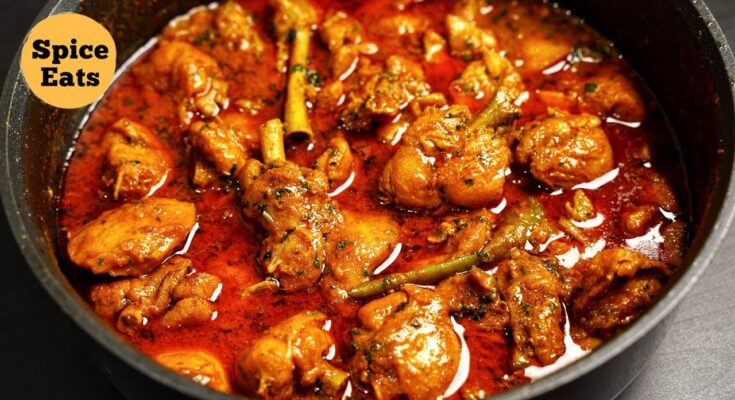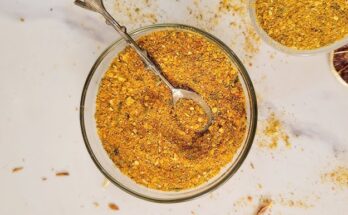Chicken and Gravy Recipe: Nothing says comfort food like a warm, hearty serving of chicken and gravy. It’s one of those dishes that brings back memories of family dinners and lazy weekends.
The beauty of this recipe is its versatility—you can customize the flavors, add your favorite herbs, or even toss in some vegetables to make it your own.
Whether you’re preparing a cozy meal for your family or impressing guests, this step-by-step guide will walk you through everything you need to know for perfect chicken and gravy.
Ingredients Required for Chicken and Gravy
You can’t make a delicious dish without the right ingredients. Here’s a breakdown of what you’ll need for both the chicken and the gravy.
Chicken Ingredients
- 4 bone-in, skin-on chicken thighs (or chicken breasts if preferred)
- 2 tablespoons olive oil
- 1 teaspoon salt
- ½ teaspoon black pepper
- 1 teaspoon paprika (optional for added flavor)
Gravy Ingredients
- 2 tablespoons butter
- 2 tablespoons all-purpose flour
- 2 cups chicken broth (preferably low-sodium)
- ½ cup heavy cream (for a richer gravy)
- 1 teaspoon garlic powder
- 1 teaspoon onion powder
- Salt and pepper to taste
- Fresh parsley (for garnish)
Equipment Needed to Prepare Chicken and Gravy
To ensure smooth preparation, gather all your equipment beforehand:
- Large skillet or frying pan
- Tongs for turning the chicken
- Whisk (for lump-free gravy)
- Measuring cups and spoons
- Chopping board and knife
- Mixing bowl (for marinating)
Preparation Steps Before Cooking
Marinating the Chicken
Before cooking, marinating the chicken adds extra flavor and tenderness. You can create a quick marinade by combining olive oil, salt, pepper, paprika, and a dash of lemon juice. Let the chicken rest in the marinade for 30 minutes to an hour. If you’re short on time, even 15 minutes will enhance the taste.
Chopping and Dicing Vegetables (Optional)
If you plan to add vegetables like onions, mushrooms, or carrots to the gravy, chop them now. Having everything ready before you start cooking helps prevent any last-minute scrambling.
Step 1: Searing the Chicken
Now it’s time to get that golden, crispy exterior on the chicken. Heat 2 tablespoons of olive oil in a large skillet over medium-high heat. Once the oil is hot, add the chicken pieces skin-side down. Sear them for about 4-5 minutes until they turn a beautiful golden brown. Flip the chicken and sear the other side for another 3-4 minutes.
Tip: Don’t overcrowd the pan—cook the chicken in batches if necessary. Overcrowding prevents the chicken from browning properly. Once seared, remove the chicken and set it aside.
Step 2: Preparing the Base of the Gravy
With the chicken out of the pan, it’s time to create the gravy’s flavor base. In the same pan, melt 2 tablespoons of butter. If there are brown bits left from the chicken, leave them—they add depth to the gravy’s flavor. Slowly sprinkle in 2 tablespoons of flour while whisking continuously. This creates a roux, which thickens the gravy.
Keep whisking until the roux turns a light golden color. This should take about 2-3 minutes. Be careful not to burn the flour!
Step 3: Cooking the Chicken in the Gravy
Pour in the chicken broth gradually while whisking to ensure a smooth consistency. Add the garlic powder, onion powder, salt, and pepper. Bring the mixture to a gentle simmer, then return the seared chicken to the pan.
Cover the pan with a lid and let it simmer on low heat for 20-25 minutes. The chicken will absorb the rich, savory flavors of the gravy while finishing its cooking process.
Step 4: Adding Seasonings and Enhancements
The flavor of your gravy is what ties this entire dish together. Once the chicken has simmered in the broth for about 15 minutes, it’s time to enhance the gravy with additional seasonings and optional ingredients.
Herbs and Spices for Flavor
For a classic flavor profile, try adding fresh herbs like rosemary, thyme, or parsley. Dried versions of these herbs can also work if that’s what you have on hand. Want a slightly earthy or smoky flavor? A dash of smoked paprika or a pinch of ground cumin can do wonders.
Adjusting Salt and Pepper
Taste your gravy and adjust the salt and pepper levels to your liking. Since chicken broth can be salty, be cautious when adding extra salt. Black pepper brings a mild heat that balances the richness of the gravy, so sprinkle to your preference.
Step 5: Simmering and Thickening the Gravy
Now comes the moment when your gravy transforms from thin and runny to thick, silky, and luscious. If the gravy seems too thin after simmering the chicken, here’s how you can thicken it further:
- Use a flour slurry: In a small bowl, mix 1 tablespoon of flour with 2 tablespoons of water until smooth. Gradually whisk this into the gravy and let it simmer for a few more minutes.
- Add cream for richness: Slowly stir in ½ cup of heavy cream to make the gravy velvety and decadent.
If the gravy is too thick, you can loosen it by adding a splash of chicken broth or water. Allow everything to simmer gently for another 5-10 minutes, letting the flavors deepen.
Cooking Time and Temperature Details
Perfect chicken requires careful attention to both time and temperature. The total cooking time, including searing and simmering, should be around 35-40 minutes. Here’s a quick breakdown:
- Searing: 4-5 minutes per side
- Simmering: 20-25 minutes
- Internal temperature: The chicken is fully cooked when it reaches an internal temperature of 165°F (75°C). Use a meat thermometer to check for accuracy.
Cooking over low heat during the simmering process ensures that the chicken stays juicy and tender.
Tips for a Perfect Chicken and Gravy
Achieving restaurant-quality chicken and gravy isn’t difficult if you follow these simple tips:
Avoiding Common Mistakes
- Don’t rush the searing process: The golden crust on the chicken adds both flavor and texture.
- Don’t skip the roux: Skipping this step can result in a watery, flavorless gravy.
- Monitor your seasoning: Taste as you go to prevent under- or over-seasoning.
Adding a Unique Touch
Want to impress your guests? Try these creative variations:
- Add sautéed mushrooms and onions for an earthy, savory twist.
- For a tangy flavor boost, stir in a splash of white wine or apple cider vinegar.
Serving Suggestions
Chicken and gravy pairs wonderfully with a variety of sides. Here are some ideas to complete your meal:
- Mashed potatoes: The classic choice for soaking up every last drop of gravy.
- Buttered rice: A simple yet flavorful option that balances the dish.
- Steamed vegetables: Broccoli, green beans, or carrots add color and nutrition.
- Biscuits: Fluffy, buttery biscuits are perfect for sopping up that rich, creamy gravy.
Arrange the chicken and sides on a serving platter, spoon the gravy generously over the top, and garnish with fresh parsley for a vibrant finishing touch.
Variations of the Chicken and Gravy Recipe
This recipe is highly adaptable. Here are two popular variations to inspire your creativity:
Creamy Mushroom Gravy
Sauté sliced mushrooms in butter before preparing the roux. The mushrooms add a rich, earthy depth to the gravy that complements the chicken beautifully.
Spicy Chicken Gravy
For a bolder taste, add cayenne pepper or crushed red pepper flakes to the gravy. You can also incorporate a teaspoon of hot sauce for a fiery kick.
Nutritional Information for Chicken and Gravy
Here’s a general breakdown of the nutritional values for one serving (including chicken and gravy):
| Nutrient | Amount per Serving |
|---|---|
| Calories | 450-500 kcal |
| Protein | 35g |
| Carbohydrates | 10g |
| Fat | 28g |
| Fiber | 1g |
| Sodium | 600-800mg |
Please note that nutritional content may vary based on portion size and specific ingredients used.
Storing and Reheating Leftovers
If you have leftovers, store them properly to maintain their flavor and texture.
- Refrigeration: Transfer the chicken and gravy to an airtight container and store in the fridge for up to 3-4 days.
- Freezing: You can also freeze the dish for up to 3 months. Let it cool completely before sealing it in a freezer-safe container.
When reheating, warm the chicken and gravy on the stovetop over low heat. Add a splash of broth to refresh the gravy’s consistency.
FAQs about Chicken and Gravy Recipe
1. What ingredients do I need for a basic chicken and gravy recipe?
To prepare a simple chicken and gravy dish, you’ll need chicken (breasts or thighs), butter, flour, chicken broth, and seasonings such as salt, pepper, and herbs like thyme or rosemary.
2. How long does it take to cook chicken and gravy?
The total cooking time for chicken and gravy is typically around 30 to 40 minutes. This includes browning the chicken, making the roux, and simmering everything together to enhance the flavors.
3. Can I make chicken and gravy without flour?
Yes, you can make gravy without flour by using alternatives like cornstarch or arrowroot powder to thicken the sauce. These options are also gluten-free.
4. Is chicken and gravy recipe suitable for freezing?
Chicken and gravy freezes well. Ensure the dish is cooled completely before transferring it to an airtight container. It can be stored in the freezer for up to 3 months.
5. What are some tips for making the best chicken and gravy?
For the best results, sear the chicken at a high temperature to lock in juices before lowering the heat. Use fresh broth for the gravy and simmer it with a bay leaf for added depth. Lastly, adjust the seasoning with salt and pepper before serving to tailor it to your taste.
6. Can I use chicken with bones for making gravy?
Absolutely! Cooking chicken with bones can add more flavor to the gravy. Just be sure to remove the bones after cooking before serving.
7. What sides go well with chicken and gravy?
Popular side dishes include mashed potatoes, steamed vegetables, or rice. These sides complement the rich flavor of the gravy and make for a satisfying meal.
Conclusion
Congratulations! You’ve now mastered a classic chicken and gravy recipe that’s perfect for any occasion. With this guide, you can create a delicious meal packed with rich flavors and comforting textures. Whether you’re cooking for a weekday dinner or a special celebration, this recipe is sure to impress.



